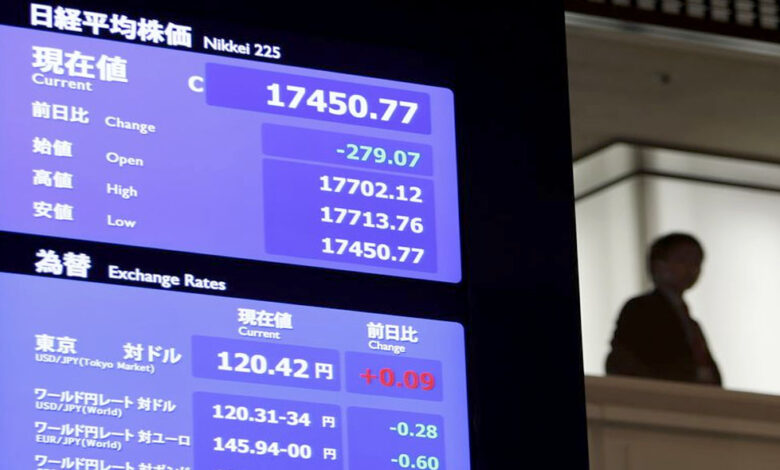Stocks Take a Slide, US Yields Climb Amid Hawkish Fed, and China Tensions Heat Up

The stock markets in the Asia-Pacific region experienced a decline on Thursday, following the downward trend in global equities. This came after the U.S. Federal Reserve reaffirmed its hawkish stance, while escalating trade tensions between China and the United States further dampened market sentiment.
In Tokyo trading, the U.S. 10-year Treasury yields reached a fresh four-month high, and the dollar continued to rise against major currencies.
However, the yen proved to be an exception as it strengthened against its U.S. counterpart, causing concerns among traders about potential currency intervention.
Japan’s Nikkei share average plummeted by 1.6%, continuing its retreat from the 33-year highs it had previously achieved.
Hong Kong’s Hang Seng also experienced a significant decline of more than 3%, while mainland blue chips lost 0.7%.
In Australia, the stock benchmark slid by 1.2%, and Taiwan shares retreated by 1.6%.
Reflecting the negative sentiment, MSCI’s broadest index of Asia-Pacific shares dropped by 1.3%, following a 0.4% decline in the global index on Wednesday.
Looking ahead, U.S. E-mini stock futures indicated a 0.4% lower restart for the S&P 500, following its 0.2% drop overnight.
Similarly, U.K. FTSE and German DAX futures each fell by about 0.4%.
While most Federal Reserve officials agreed to maintain steady interest rates last month, the meeting minutes released on Wednesday revealed that the vast majority anticipated the need for eventual tightening of monetary policy.
Money market traders currently place 85% odds on a quarter-point hike on July 26, with approximately a 50/50 chance of another increase by November.
Meanwhile, U.S. Treasury Secretary Janet Yellen embarks on a trip to China at a time when Beijing has imposed restrictions on metal exports used in the production of semiconductors. Chinese officials have stated that these controls are just the beginning.
Matt Simpson, a market analyst at City Index, remarked, “Sentiment has soured for equity bulls as Sino-U.S. relations take another step backwards, and investors are adjusting to the fact that the Fed remains more hawkish than expected.”
He further added, “The Fed’s decision to pause was not unanimous, and most members are in favor of further rate hikes, so this could limit upside potential in the near term.”
During Tokyo trading, the ten-year Treasury yields surged to as high as 3.965%, marking a substantial increase of 9 basis points overnight.
The U.S. dollar index, which measures the currency against six peers including the euro and yen, extended its gain of 0.23% from Wednesday to reach as high as 103.46 during Asian trading.
However, the dollar weakened against the yen, despite the historical correlation between the currency pair and long-term U.S. yields.
On Thursday, the dollar declined by 0.54% against the yen, erasing all the gains made on the previous day.
Japanese officials have been issuing daily warnings about yen weakness as it approaches the 145 level that triggered intervention last autumn. Last Friday, the dollar briefly touched 145.07 yen.
Naka Matsuzawa, chief strategist at Nomura Securities in Tokyo, stated, “The yen is kind of stuck because the Japanese government has raised concerns about the currency. Verbal intervention can only be effective
for a limited period, and it’s only a matter of time before the yen reaches that 145 level due to rising U.S. yields and the Bank of Japan’s dovish stance.”
Matsuzawa added, “The market now has no doubts about the Fed’s policy stance, which is as hawkish as it can get. They are prepared for multiple rate hikes, and the threshold for further increases is quite low.”
In the energy market, oil prices slipped during Asian trade on Thursday. The fears of a sluggish demand recovery in China, the world’s top crude importer, outweighed the prospect of tighter supply caused by production cuts by major exporters Saudi Arabia and Russia.
Brent crude futures dipped by 25 cents, or 0.3%, to $76.40 a barrel after experiencing a 0.5% increase the previous day.
Similarly, U.S. West Texas Intermediate crude fell by 7 cents, or 0.1%, to $71.72 a barrel. This came after a 2.9% surge in post-holiday trade on Wednesday, catching up with the gains made by Brent earlier in the week.
The current market conditions reflect a challenging landscape for investors. With the Federal Reserve maintaining a hawkish stance, tensions between China and the United States escalating, and concerns about global demand, market participants face uncertainties and potential risks.





